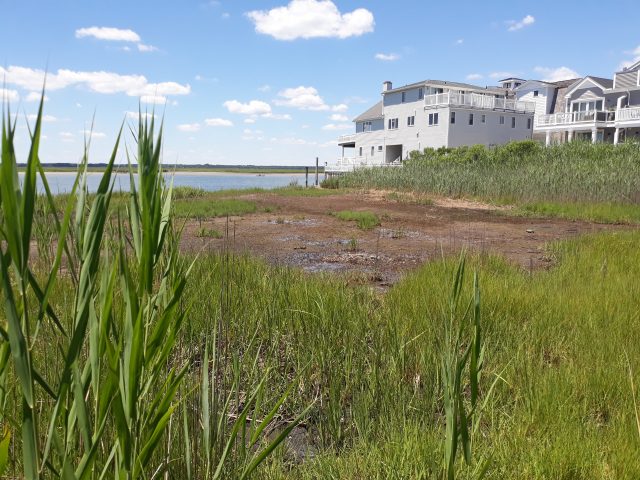By DONALD WITTKOWSKI
This was Sea Isle City’s version of “Let’s Make a Deal.”
The negotiations involved three distinct parties: Local residents, the city and a family that has owned a piece of bayfront property on 81st Street since the 1950s.
Tucked behind the curtains — actually, tall marsh reeds at the end of 81st Street — are two lots that are essentially muddy, nondescript wetlands overlooking the back bays.
Looking to protect the property from possible development, the city has joined up with surrounding homeowners for a $300,000 funding package to buy the lots and settle a lawsuit with family members who once wanted to use the land to build a house. The city is chipping in $250,000, while the homeowners are contributing $50,000 for the deal.
City Solicitor Paul Baldini explained that such an arrangement between the town and private homeowners might be unusual for other communities, but not for Sea Isle.
“Sea Isle has always been willing to work with homeowners, probably more than other communities. We have a history of public-private partnerships working for a common goal,” Baldini said.
Sea Isle is lining up the money and reviewing the final documents in anticipation of closing the deal in August, Baldini said. City Council has given its approval for Sea Isle’s $250,000 share of the funding package.
Altogether, about 10 homeowners in the 81st Street neighborhood are providing the $50,000, Baldini said. He referred questions to their attorney, Raymond Went, who was not available for comment Friday.
Once the purchase is completed, the city will take ownership of the property and the land will be deed-restricted as a conservation easement to protect it from development, Baldini said.
Sea Isle previously had discussed the possibility of using the bayfront land for a small kayak launch site, but has since backed away from that idea. Instead, the land will be preserved as open space, Baldini said.
“The draft agreement calls for it being left in its present state,” he said.
The buyout will settle a lawsuit filed against Sea Isle and the city’s zoning board by property owners Shirley A. Kling and Terrance L. Crowley, who sued in 2019 after they were denied approval to build a home in a wetlands conservation zone that is part of the bayfront land.
Baldini said Kling and Crowley originally had sought a buyout of $875,000, but settled for $300,000.

Robert Baranowski, a Marlton, N.J., attorney who represents Kling and Crowley, said in an earlier interview that Kling and Crowley wanted to settle and were “trying in good faith” to resolve the litigation.
The settlement ends what could have become a lengthy and expensive legal battle that would have hurt both sides, Baldini said.
“I also think this was a fair settlement,” he added.
While the city considers part of the property to be within a wetlands conservation zone protected from housing construction, Kling and Crowley wanted to use half of the land to build a vacation home.
The lot that Kling and Crowley had proposed to develop for their home is unusual because half of it is zoned for housing construction, while the other half lies within the wetlands conservation area.
Under Sea Isle’s zoning laws, areas that are designated for wetlands conservation are restricted to “recreational fishing and crabbing, boating, passive recreation and environmental study.” Home construction is not allowed in those areas.
Kling and Crowley had sought a variance from Sea Isle’s zoning board in 2019 to build the house within the wetlands conservation zone, but it was denied by a 5-1 vote.
The zoning board refused to grant the variance after expressing concerns about flooding in the neighborhood. Board members also said they did not want to set a precedent by allowing a new home to be built in a wetlands conservation area.
During the zoning board meeting, opponents who live in the surrounding neighborhood testified against the proposed home. They expressed fear that the project would harm the environment and exacerbate flooding in the neighborhood.
Kling and Crowley, whose families have owned the property since 1957, had argued that their project “satisfied all criteria” for a variance and would not have a negative impact on wetlands, flooding, threatened or endangered wildlife or other environmental concerns.
After they were turned down, they filed a lawsuit that alleged the zoning board was “arbitrary, capricious and unreasonable” in its decision to reject the variance. They asked a Superior Court judge to overturn the board’s ruling, but their appeal was denied.
Prior to coming before the zoning board, Kling and Crowley had obtained approvals from the New Jersey Department of Environmental Protection and the U.S. Army Corps of Engineers to build a single-family home on the same site, according to their suit.
In addition to naming the zoning board in their suit, Kling and Crowley also sued the city of Sea Isle. That part of the litigation focused on an issue known as “inverse condemnation.” It is a legal term to describe when government takes private property but fails to pay the required “just compensation” for the land.
However, the settlement also ends the inverse condemnation claim, Baldini said.








